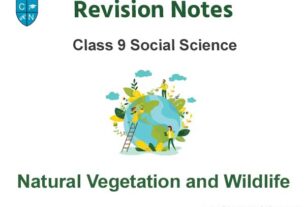Please refer to Pastoralists in the Modern World Class 9 Notes and Questions with solutions below. These revision notes and important examination questions have been prepared based on the latest Social Science books for Class 9. You can go through the questions and solutions below which will help you to get better marks in your examinations.
Pastoralists in the Modern World Class 9 Notes and Questions
NOMADISM AS A WAY OF LIFE
The Mountain Nomads
- The Gujjar Bakarwals of Jammu and Kashmir — They are pastoral nomads who move in groups called ‘Kafila’. Their movements are governed by the cold and snow. In winters when the high mountains are covered with snow these Gujjars move down to the low hills of the Shiwaliks range. On the onset of summer, when the snow melts and the mountains become lush and green, these pastoralists move back to the mountains.
- The Gaddi Shepherds of Himachal Pradesh have a similar cycle of movement. They also spend the winter on the low Shiwaliks hills and the summers in Lahul and Spiti.
- The Gujjar cattle herders of Kumaon and Garhwal spend their summers in the ‘bugyals’ and their winters in the ‘bhabar’.
- The Bhotias, Sherpas and Kinnauri follow the cyclic movement which helps them to adjust to seasonal changes and make best use of pastures.
Onthe plateaus, plains and deserts —
- The Dhangars of Maharashtra : The Dhangars stay in the central plateau of Maharashtra during the monsoon. This is a semi-arid region. By October they begin their movement towards Konkan. Here their cattle help to manure the fields and hence they are welcomed by the Konkani peasant. As soon as the monsoon sets in, they retreat back to the semi-arid land of Maharashtra.
- The Gollas who herd cattle and the Kurumas and Kurubas who reared sheep and goat are from Karnataka and Andhra. They live near the woods and in the dry periods they move to the coastal tracts.
- The Banjaras of Uttar Pradesh, Punjab, Rajasthan, Madhya Pradesh and Maharashtra move to different places in search of good pastures.
- The Raikas of Rajasthan combine cultivation with pastoralism. When their grazing grounds become dry they move to new and greener pastures.
- Pastoral life was sustained by their sense of judgement to know how long one must stay in an area to know where they could find food and water
- to assess and calculate the timings of their movement
- their ability to set up a relationship with the farmers so that the herds could graze on the harvested fields.
CHANGES IN PASTORAL LIFE DUE TO COLONIAL RULE
- Under colonial rule the life of the pastoralists changed completely. Their grazing grounds became less, their movements were regulated, the revenues they had to pay increased, their trade and crafts and agricultural produce declined.

- Colonial administration saw the pastoral land as a waste land that needed to be cultivated.In most areas the grazing tracts used regularly by pastoralists was taken for cultivation.
- The forests which were demarked as ‘Protected’ and ‘Reserved’ completely restricted the movements of pastoralists.
- It completely disturbed the life of the pastoralists.
- British distrusted mobile craftsman and traders.They preferred settled population for proper control.
- the 1871 Criminal Tribes Act classified many communities of craftsman,traders and pastoralists as criminal tribes.
- More amount of taxes were imposed to increase revenue income. Pastoralists suffered heavily from that.
Coping with changes —
- Some reduced the number of cattle in their herds.
- Some discovered new pastures.
- Some bought land and began to lead a settled life.
- Some poor peasants borrowed money to survive, in due course of time they lost their cattle and sheep and became labourers.
PASTORALISM IN AFRICA
Africa was a major pastoralists community in the world. Even today 22 million Africans depend on some form of pastoral activity for their livelihood. They include communities like Bedouins, Berbers, Maasai, Somali, Boran and Turkana.
The Maasai — Changes in their way of life
The Maasai cattle herders live primarily in East Africa. Rules, laws and regulations have changed their way of life. There are many problems which they have faced, the most prominent being continuous loss of their grazing grounds. This has many reasons :
- scramble for territorial possessions in Africa.
- dividing the region into different colonies.
- best grazing grounds being taken over by the white settlements.
- grazing grounds being converted to cultivated land and national parks and game reserves.
The Kaokoland herders have faced a similar fate.
Confinedto special reserves — Traditionally, pastoralists moved to different pastures but with the restrictions imposed on them these pastoralists were confined to special reserves. They could not move without special permits. They were not allowed to enter the markets in white areas.Some tribes were affected by the Criminal Tribes Act. Even their trade activities were adversely affected.
Why nomadism — Pastoralists are nomadic — this allows them to survive bad times and avoid crises, such as drought. But later they could not shift to greener pastures and their cattle died of starvation.
The Maasai society consisted of
Elders: ruling group decided the affairs of the community and settled disputes
Warriors: young men who carried out cattle raids and defended the community
The British appointed chiefs to administer the affairs of the tribe. These chiefs were wealthy and lived a settled life as they had both pastoral and non-pastoral income. The poor pastoralists passed through bad times and worked as labourers. There were two important changes :
The traditional difference between the elders and warriors was disturbed. There came to be a marked difference between the rich and poor.
Developments within Pastoral Societies
With increasing restrictions on their mobility , pastoralists find it difficult to move in search of pastures. It strains the existing pastures by overgrazing. The pastures deteriorate. The condition like drought worsens the situation.
Pastoralists adapt to new times. They find new pastures, change their routes for their annual movement, reduce their cattle numbers, press for their rights, etc. It is being advocated today that pastoral nomadism is the best form of life suited to the dry, semi-arid and mountainous regions of the world

We hope the above Pastoralists in the Modern World Class 9 Notes and Questions are useful for you. If you have any questions then post them in the comments section below. Our teachers will provide you an answer. Also refer to MCQ Questions for Class 9 Social Science


